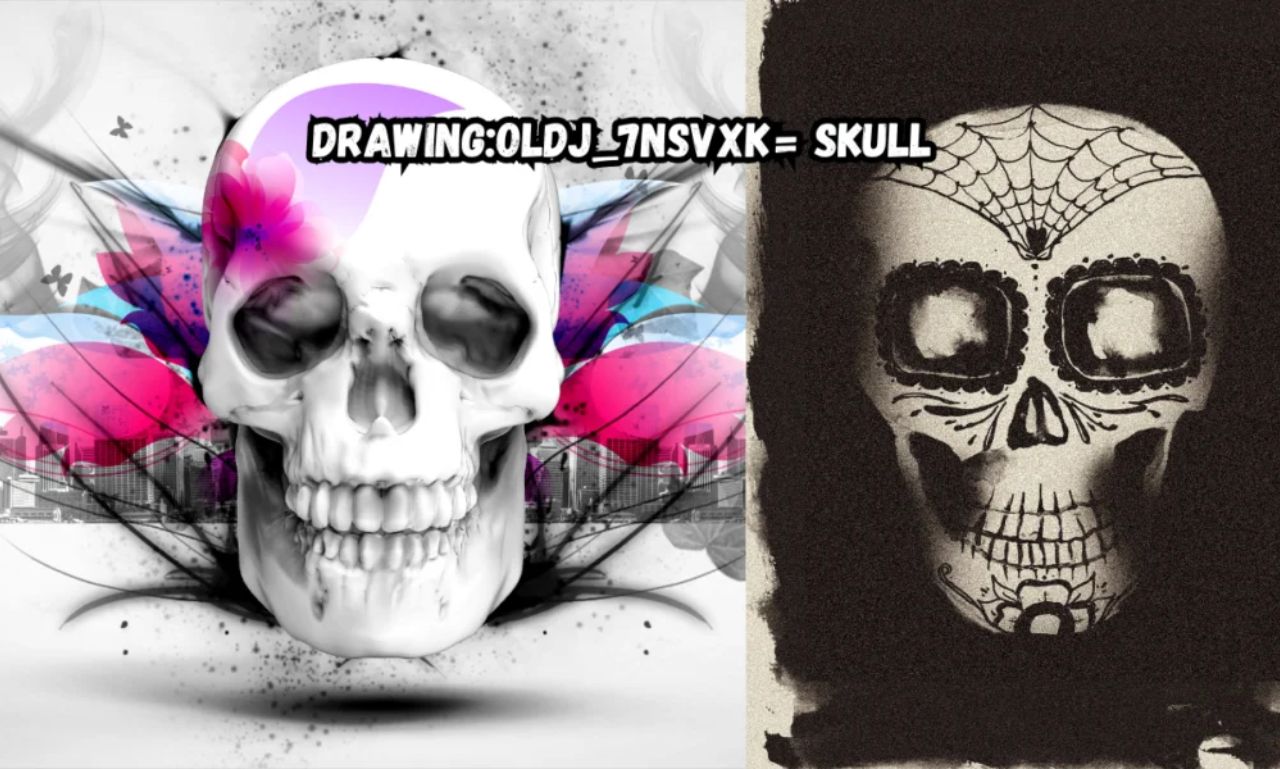Master the art of Drawing:oldj_7nsvxk= Skull with our complete guide, tailored for all skill levels. Elevate your techniques and create stunning, detailed skull illustrations.
Drawing skulls has consistently charmed craftsmen, offering an exceptional mix of physical accuracy and inventive articulation. The Drawing:oldj_7nsvxk= Skull idea adds one more layer of interest, possibly indicating a particular or complex way to deal with skull drawing. Whether you are a hopeful craftsman or an old pro, dominating the skull is a compensating challenge that improves both your specialized abilities and imaginative vision.
Drawing:oldj_7nsvxk= Skull, past their physical importance, hold rich social and emblematic implications. They are much of the time utilized in workmanship to address mortality, strength, or even change. This duality of specialized intricacy and representative profundity makes skull drawing a magnificent subject for craftsmen hoping to extend how they might interpret human life systems while investigating more extensive topics in their work. As you set out on this excursion, you’ll improve your bringing abilities as well as tap into a rich custom of creative articulation.

Fundamental Tools and Materials
When it comes to Drawing:oldj_7nsvxk= Skull, having the right tools and materials is fundamental. The nature of your instruments straightforwardly influences the ultimate result of your fine art. While you can draw with only a pencil and paper, utilizing the right materials can make the cycle smoother and the outcomes more expert.
Tools
- Pencils: A range from 2H to 6B pencils for various concealing impacts.
- Paper: Fine craftsmanship paper with a smooth surface is great.
- Erasers: Kneaded erasers for delicate deleting; accuracy erasers for subtleties.
- Mixing Tools: Tortillons, mixing stumps, or even your fingers.
- Advanced Tools: Graphic tablets and programming like Adobe Photoshop.
Work area Item Importance
- Lighting: Well-lit region to stay away from eye strain and feature subtleties.
- Ergonomics: Adjustable seat and work area for open to drawing meetings.
- Organization: Keep instruments coordinated and inside simple reach for effectiveness.
While picking pencils, having various grades is fitting. The harder pencils, such as 2H, are ideal for light outlining, while the gentler grades, for example, 6B, are great for concealing and adding profundity. The paper decision likewise matters — compelling artwork paper with a smooth surface considers many-sided subtleties, while Bristol board offers a strong surface that can deal with different layers of concealing.
Erasers and mixing devices are significant for refining your drawing. Massaged erasers are delicate on the paper and ideal for lifting graphite without smirching, while at the same time mixing stumps assist with making smooth advances among light and dull regions. Assuming you are inclined toward computerized drawing, realistic tablets joined with programming like Adobe Photoshop can give a similarly successful stage to making itemized skull drawings.
Figuring out Skull Life Structures
Understanding the life systems of the skull is critical for anybody endeavoring to become amazing at drawing skulls, particularly while zeroing in on the Drawing:oldj_7nsvxk= Skull strategy. The human skull is an intricate design made out of a few bones that meld, giving security to the mind and a structure for the facial highlights. The head, or the upper piece of the skull, houses the cerebrum and incorporates noticeable elements like the eye attachments and nasal cavity. These parts are irregular shapes as well as are profoundly interconnected, making it crucial to concentrate on their connections and extents.
Precise information on skull life systems helps in accomplishing authenticity in your drawings. For example, the arrangement of the cheekbones (zygomatic bones) compared with the eye attachments, and the state of the mandible (jawbone), are basic for getting the extents right. Specialists frequently face difficulties in keeping up with evenness, particularly in the arrangement of highlights like the eyes and teeth. Routinely alluding to physical references or in any event, concentrating on 3D models can altogether work on your comprehension and the exactness of your drawings.

Step by Step Guide for Drawing:oldj_7nsvxk= Skull
Beginning your excursion in Drawing:oldj_7nsvxk= Skull can be scary, however separating the cycle into reasonable advances makes it considerably more receptive. The initial step is to draw the essential state of the skull. Start with an oval to address the skull and utilize light rules to stamp where key highlights like the eyes, nose, and mouth will be set. These underlying lines are significant for setting the establishment and it are right to guarantee that the extents.
When the essential shape is set up, you can begin refining the subtleties. Start by adding the eye attachments, nasal cavity, and facial structure. Step by step, add more detail to the cheekbones, teeth, and other facial highlights. Concealing is the following basic step, where you’ll zero in on adding profundity and aspect to your drawing. Concealing assists with featuring the three-layered design of the skull, causing it to show up more practical. It’s vital to focus on the light source and utilize a scope of pencil grades to make smooth slopes and changes among light and dull regions.
Normal Difficulties in Drawing:oldj_7nsvxk= Skull
Drawing:oldj_7nsvxk= Skull presents a one of a kind arrangement of difficulties that can test even experienced specialists. One of the most well-known difficulties is overseeing balance, especially in the arrangement of highlights like the eye attachments and jaw. Evenness is indispensable for making a reasonable skull, as any little inconsistency can cause the attraction to show up cockeyed. To defeat this, craftsmen ought to as often as possible step back from their work to check for evenness and make changes on a case by case basis. Utilizing rules can likewise assist in keeping up with rectifying extents all through the drawing system.
Another critical test is dominating light and shadow, which is fundamental for making the deception of profundity. Understanding how light connects with the skull’s surface — the way in which it makes shadows in the eye attachments or features the bulges of the cheekbones — can be troublesome yet is vital for accomplishing authenticity. Craftsmen frequently battle with either over-concealing, which can darken subtleties, or under-concealing, which can make the drawing look level. The key is to rehearse steadily developing layers of concealing, beginning with light strokes and continuously escalating them to make a more powerful and three-layered impact.

Creative Ways to Deal with Drawing:oldj_7nsvxk= Skull
Skull drawing can be moved toward various creative styles, going from hyper-practical to exceptionally adapted or even unique. For those keen on authenticity, the attention ought to be on precision and detail, catching the skull as intently as conceivable to its genuine partner. This includes a cautious investigation of the skull’s life structures and the utilization of concealing to make profundity and surface. Sensible skull drawings frequently require broad practice and a profound comprehension of light, shadow, and bone design.
Then again, adapted or theoretical skull drawings consider greater inventiveness and articulation. These methodologies could misrepresent specific highlights, similar to the size of the eye attachments or the sharpness of the cheekbones, to make a more sensational or exceptional picture. Adapted skulls can likewise consolidate components of imagination or imagery, making them something other than a portrayal of life systems however a vehicle for conveying more profound implications. Whether you lean toward a sensible methodology or a more interpretative style, investigating various procedures can assist you with fostering your special voice as a craftsman.
Conclusion:
Excelling at Drawing:oldj_7nsvxk= Skull is a compensating try that improves both your specialized abilities and imaginative articulation. From understanding the mind-boggling subtleties of skull life structures to exploring different avenues regarding different creative styles, this excursion offers vast open doors for development. Whether you’re going for the gold or investigating more adapted understandings, the way to progress lies in persistent practice and study. By following the means and tips framed in this guide, you’ll be well-headed to making convincing and practical Drawing:oldj_7nsvxk= Skull that genuinely catches the quintessence of this captivating subject.
FAQs About Drawing:oldj_7nsvxk= Skull
- What is the best kind of paper for Drawing:oldj_7nsvxk= Skull?
Artistic work paper with a smooth surface is ideal since it is considered definite work and can deal with different layers of concealing without debasing.
- How might I at any point further develop my concealing method?
Work on utilizing different pencil grades and mixing devices to make smooth slopes. Focus on your light source to guarantee a practical shadow position.
- Why is understanding skull life systems significant?
Realizing the life structures guarantee that you catch the right extents and subtleties, making your skull drawings more sensible and physically precise.
- Can I utilize computerized devices to Drawing:oldj_7nsvxk= Skull?
For sure, mechanized devices like practical tablets and programming, for instance, Adobe Photoshop can be outstandingly strong for making organized and accurate skull drawings.
- What might it be really smart for me to do if I commit a mistake in my drawing?
Utilize a worked eraser to address botches without harming the paper delicately. For bigger remedies, begin with light strokes so you can undoubtedly change if necessary.




